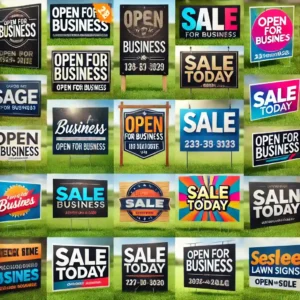In the competitive landscape of real estate, standing out is crucial. Custom Real Estate Signs are an essential tool for agents and property owners looking to enhance visibility and convey professionalism. These signs serve not just as markers but as powerful branding instruments that can attract potential buyers and sellers alike.
Understanding the Importance of Custom Real Estate Signs
A well-designed sign can speak volumes about a property and its agent. In a bustling market like Toronto, custom Real Estate Signs in Toronto play a pivotal role in grabbing attention. These signs are often the first point of contact between a property and prospective buyers. As such, they must effectively communicate essential information while embodying the unique identity of the real estate professional.
Types of Real Estate Signs
When considering types of real estate signs, it’s essential to recognize the various categories available. Each type serves a specific purpose and can be tailored to meet unique marketing strategies:
- For Sale Signs: These are the most common type, prominently displayed in front of properties for sale. They usually include the property’s price, the agent’s contact information, and sometimes a brief description.
- Open House Signs: Designed to attract foot traffic during open house events, these signs direct potential buyers to properties that are available for viewing. Their strategic placement can significantly increase attendance.
- Directional Signs: These signs guide prospective buyers to the property. They are particularly useful in neighborhoods with multiple listings, ensuring that potential clients can easily find their way.
- Sold Signs: When a property is sold, displaying a “Sold” sign not only marks the transaction but also serves as a testament to the agent’s success, attracting future clients.
- Luxury Property Signs: High-end listings often require a more sophisticated touch. Custom signs for luxury properties typically feature upscale designs and materials, reflecting the exclusivity of the listings.
- Temporary Signs: For properties undergoing renovations, temporary signs can provide information about the expected completion date or future availability. These signs maintain interest in the property even when it is not on the market.
Best Real Estate Signs
Choosing the Best Real Estate Signs involves a blend of effective design, durable materials, and strategic messaging. Signs should be eye-catching and informative while aligning with the brand identity of the real estate agent or agency. The ideal sign will also take into consideration local zoning regulations to ensure compliance.
Selecting the Best Material for Real Estate Signs
The durability and aesthetics of a sign largely depend on the best material for real estate signs. Different materials offer unique advantages:
- Coroplast: Lightweight and cost-effective, coroplast is a popular choice for temporary signs. Its weather-resistant properties make it suitable for short-term use, such as open houses.
- Aluminum: Known for its strength and durability, aluminum signs are an excellent choice for long-term use. They resist rust and can withstand harsh weather conditions, making them ideal for outdoor settings.
- PVC: This versatile material is lightweight yet robust, making it suitable for various types of signs. PVC can be easily printed on and is often used for custom designs.
- Wood: Offering a rustic appeal, wooden signs can enhance the charm of properties, particularly in suburban or rural settings. However, they require regular maintenance to protect against weather damage.
- Acrylic: For a modern and upscale look, acrylic is often favored for luxury listings. These signs can be produced in various colors and finishes, allowing for stunning visual presentations.
Choosing the Best Colors for Real Estate Signs
Color choice plays a vital role in the effectiveness of real estate signage. The Best Colors for Real Estate Signs not only enhance visibility but also evoke specific emotions and perceptions:
- Red: This bold color can create a sense of urgency and attract immediate attention, making it a popular choice for “For Sale” signs.
- Blue: Often associated with trust and reliability, blue is an excellent choice for agents looking to establish credibility. It’s soothing and can instill confidence in potential clients.
- Green: Representing growth and tranquility, green is particularly effective for eco-friendly properties or those located in natural settings.
- Yellow: Bright and cheerful, yellow can attract attention without being overwhelming. It’s a great choice for directional signs or open house notifications.
- Black and White: This classic combination conveys sophistication and elegance. It’s often used in luxury real estate to create a timeless and professional appearance.
Understanding Real Estate Signs Cost
When investing in real estate signs, understanding the associated costs is crucial. The Real Estate Signs Cost can vary significantly based on several factors:
- Material Selection: As discussed, the choice of material greatly influences price. High-quality materials like aluminum or acrylic will generally cost more than coroplast.
- Size and Design: Larger signs or those with intricate designs will incur higher production costs. Custom graphics and logos can also increase expenses.
- Quantity: Purchasing signs in bulk can lead to discounts, reducing the overall cost per sign. This is particularly beneficial for real estate agencies with multiple listings.
- Printing Method: Different printing techniques, such as digital printing or screen printing, have varying costs associated with them. Digital printing is often more suitable for intricate designs, while screen printing can be more economical for simpler designs.
- Installation Costs: If hiring professionals for installation, additional labor costs should be factored into the overall budget. DIY installation can save money but requires tools and time.
- Here’s a table summarizing the information about custom Real Estate Signs in a clear and concise manner:
| Title | Description |
| Types of Real Estate Signs | 1. For Sale Signs: Indicating properties available for sale. 2. Open House Signs: Informing about open house events. 3. Directional Signs: Guiding buyers to the property. 4. Sold Signs: Indicating properties that have been sold. 5. Luxury Real Estate Signs: Designed for high-end properties with unique designs. 6. Temporary Signs: Used for properties under renovation. |
| Best Material for Signs | 1. Coroplast: Lightweight and cost-effective, ideal for temporary use. 2. Aluminum: Durable and suitable for long-term outdoor use. 3. PVC: Lightweight and versatile, great for custom designs. 4. Wood: Classic and attractive, requires maintenance. 5. Acrylic: Modern and luxurious, perfect for high-end listings. |
| Best Colors for Signs | 1. Red: Evokes urgency and attracts attention. 2. Blue: Instills trust and reliability. 3. Green: Symbolizes growth and tranquility. 4. Yellow: Grabs attention without being overwhelming. 5. Black and White: Offers a classic and professional look. |
| Real Estate Signs Cost | The cost of signs varies based on factors such as material choice, size, design complexity, quantity purchased, printing method, and installation fees. |
Also read: 5 Effective Ways to Use Yard Signs
Conclusion
In the dynamic field of real estate, custom real estate signs are invaluable tools that can significantly impact marketing efforts. By understanding the various types of real estate signs available and selecting the best materials and colors, agents can create eye-catching and effective signage. While real estate signs cost can vary, the investment is crucial for establishing a strong market presence. Ultimately, the right sign can facilitate connections with potential clients and lead to successful transactions.
FAQ
1: What are custom real estate signs?
Custom real estate signs are personalized signs designed to display a specific property or brand. They can include unique designs, logos, colors, and messages to attract potential buyers or renters.
2: What types of real estate signs are there?
Types of real estate signs include for-sale signs, open house signs, directional signs, sold signs, and luxury property signs.
3: What is the best material for real estate signs?
Ideal materials include coroplast for temporary signs, aluminum for durability, PVC for vibrant designs, wood for a classic look, and acrylic for a modern appearance.
4: What are the best colors for real estate signs?
Best colors include red for urgency, blue for trust, green for growth, yellow for visibility, and black and white for a professional, classic look.
5: How much do real estate signs cost?
Prices range from $5 to $20 for basic coroplast signs to over $100 for luxury aluminum or wooden signs, especially with custom designs.
6: How can I order custom real estate signs?
Custom real estate signs can be ordered from local sign manufacturers, print shops, or online vendors that offer customization, bulk discounts, and professional design services.
7: How can I ensure my real estate sign attracts attention?
Use bold colors, clear fonts, and eye-catching designs. Incorporate unique branding and ensure the sign is placed in a visible location. Consider sign size relative to its surroundings for maximum impact.


